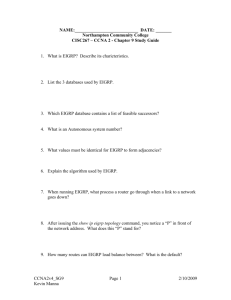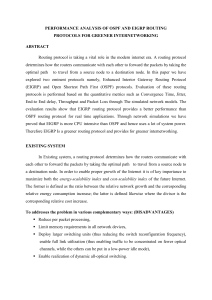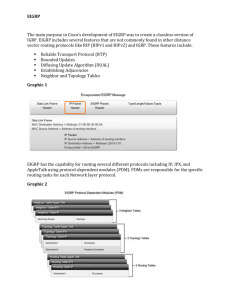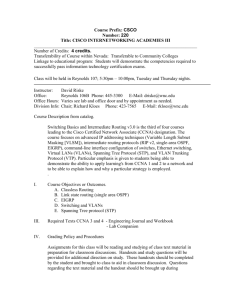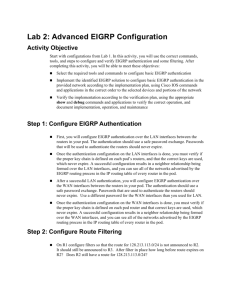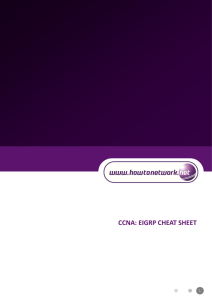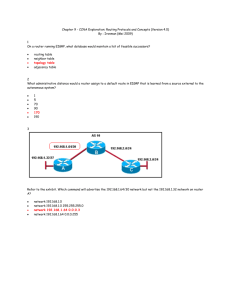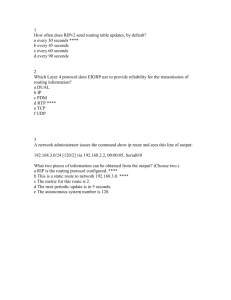Enhanced Interior Gateway Routing Protocol
advertisement
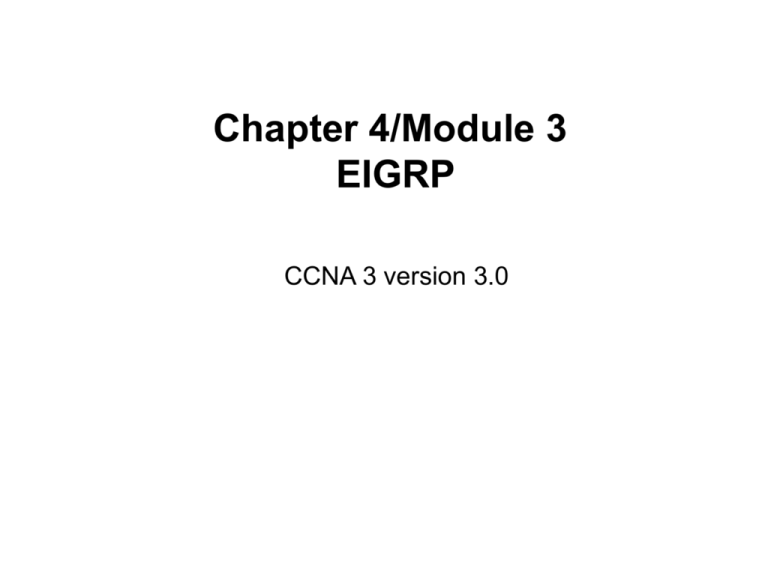
Chapter 4/Module 3
EIGRP
CCNA 3 version 3.0
EIGRP
• “Enhanced” Interior Gateway Routing Protocol
• Based on IGRP and developed to allow easy transition from IGRP to
•
•
•
EIGRP. (“Like IGRP+”)
Cisco proprietary, released in 1994
EIGRP is an advanced distance-vector routing protocol that relies on
features commonly associated with link-state protocols. (sometimes
called a hybrid routing protocol).
Note: The Hybrid term sometimes misleads people into thinking
EIGRP has the topology benefits of a link state routing protocol. It
does not. EIGRP is a distance vector routing protocol and suffers from
all of the same disadvantages of any other distance vector routing
protocol, i.e. routing loops.
• Note: “Often described as a hybrid routing protocol offering the best of
distance-vector and link-state algorithms.” - I would say “features of
distance-vector and link-state” not necessarily “the best.”
IGRP and EIGRP: A migration path
IGRP
EIGRP
Classful Routing Protocol
Classless Routing Protocol
• VLSM, CIDR
bandwidth = (10,000,000/bandwidth kbps)
delay
= delay/10
24 bit metric for bandwidth and delay
bandwidth = (10,000,000/bandwidth kbps) * 256
delay
= (delay/10) * 256
32 bit metric for bandwidth and delay
Maximum Hop Count = 255
Maximum Hop Count = 224
No differentiation between internal and
external routes.
Outside routes (redistributed) are tagged as
external routes.
Automatic redistribution between IGRP and EIGRP as long as “AS” numbers are the same.
Metric Calculation (Review)
–
–
–
–
EIGRP
bandwidth is in kbps
k1 for bandwidth
k2 for load
k3 for delay
k4 and k5 for Reliability
Router(config-router)# metric
weights tos k1 k2 k3 k4 k5
Displaying Interface Values
Router> show interface s0/0
Serial0/0 is up, line protocol is up
Hardware is QUICC Serial
Bandwidth
Delay
Description: Out to VERIO
Internet address is 207.21.113.186/30
MTU 1500 bytes, BW 1544 Kbit, DLY 20000 usec,
rely 255/255, load 246/255
Encapsulation PPP, loopback not set
Keepalive set (10 sec)
<output omitted>
Reliability
Load
shows reliability as a fraction of 255, for
example (higher is better):
rely 190/255 (or 74% reliability)
rely 234/255 (or 92% reliability)
rely 255/255 (or 100% reliability)
shows load as a fraction of 255, for
example (lower is better):
load 10/255 (or 3% loaded link)
load 40/255 (or 16% loaded link)
load 255/255 (or 100% loaded link)
Displaying Interface Values
Router> show interface s0/0
Serial0/0 is up, line protocol is up
Hardware is QUICC Serial
Bandwidth
Delay
Description: Out to VERIO
Internet address is 207.21.113.186/30
MTU 1500 bytes, BW 1544 Kbit, DLY 20000 usec,
rely 255/255, load 246/255
Encapsulation PPP, loopback not set
Keepalive set (10 sec)
<output omitted>
Reliability
Load
Routing Table Metric
• Default: Slowest of bandwidth plus the sum of the delays of
all outgoing interfaces from “this router” to the destination
network.
EIGRP Metrics
Values displayed in show interface
commands and sent in routing updates.
Media
Bandwidth
K= kilobits
BWEIGRP
10,000,000/Bandwidth
*256
100M ATM
Fast Ethernet
FDDI
HSSI
16M Token Ring
Ethernet
T1 (Serial
Default)
512K
DS0
56K
DLYEIGRP
Delay
Delay/10
*256
100,000K
100,000K
100,000K
45,045K
16,000K
10,000K
1,544K
25,600
25,600
25,600
56,832
160,000
256,000
1,657,856
100 S
100 S
100 S
20,000 S
630 S
1,000 S
20,000 S
2,560
2,560
2,560
512,000
16,128
25,600
512,000
512K
64K
56K
4,999,936
40,000,000
45,714,176
20,000 S
20,000 S
20,000 S
512,000
512,000
512,000
BWEIGRP and DLYEIGRP display values as sent in EIGRP updates and used in
calculating the EIGRP metric. Calculated values (cumulative) displayed in
routing table (show ip route).
SanJose2#show ip route
D
192.168.72.0/24 [90/2172416]
via 192.168.64.6, 00:28:26, Serial0
A Closer Look at the Routing Table
Metrics
The Routing Table
How does SanJose2 calculate the cost for this route?
Administrative Distance / Metric
SanJose2#show ip route
D
192.168.72.0/24 [90/2172416]
via 192.168.64.6, 00:28:26, Serial0
Displaying Interface Values
Westasman> show interface fa0/0
Ethernet0 is up, line protocol is up
Hardware is Lance, address is 0010.7b3a.cf84 (bia 0010.7b3a.cf84)
MTU 1500 bytes, BW 100000 Kbit, DLY 100 usec,
rely 255/255, load 1/255
<output omitted>
SanJose2> show interface s0/0
Serial0/0 is up, line protocol is up
Hardware is QUICC Serial
Description: Out to Westasman
Internet address is 192.168.64.5/30
MTU 1500 bytes, BW 1544 Kbit, DLY 20000 usec,
rely 255/255, load 246/255
<output omitted>
Determining the costs
Bandwidth = (10,000,000/bandwidth kbps) * 256
Delay =
2,560
FastEthernet
= (10,000,000/100,000) * 256
Fa0/0 192.168.72.1/24
Bandwidth =
25,600
= 25,600
Westasman
S0/0 192.168.64.2/30
S0/1 192.168.64.6/30
T1
= (10,000,000/1544) * 256
Delay =
512,000
= 1,657,856
S0/0 192.168.64.1/30
S0/0 192.168.64.5/30
Fa0/0 192.168.1.2/24
SanJose1
Bandwidth =
1,657,856
SanJose2
Fa0/0 192.168.1.1/24
EIGRP
AS 100
Determining the costs
Delay = (delay/10) * 256
Delay =
2,560
FastEthernet
= (100/10) * 256
Fa0/0 192.168.72.1/24
Bandwidth =
25,600
= 2,560
Westasman
S0/0 192.168.64.2/30
S0/1 192.168.64.6/30
T1
= (20,000/10) * 256
Delay =
512,000
= 512,000
S0/0 192.168.64.1/30
S0/0 192.168.64.5/30
Fa0/0 192.168.1.2/24
SanJose1
Bandwidth =
1,657,856
SanJose2
Fa0/0 192.168.1.1/24
EIGRP
AS 100
Determining the costs
What is the cost (metric) for 192.168.72.0/24 from SanJose2?
Delay =
2,560
Cost: Slowest bandwidth
+ sum of delays
1,657,856
512,000
2,560
-------------2,172,416
Fa0/0 192.168.72.1/24
Bandwidth =
25,600
Westasman
S0/0 192.168.64.2/30
S0/1 192.168.64.6/30
Delay =
512,000
The cost!
S0/0 192.168.64.1/30
S0/0 192.168.64.5/30
Fa0/0 192.168.1.2/24
SanJose1
SanJose2
Fa0/0 192.168.1.1/24
bandwidth = (10,000,000/bandwidth kbps) * 256
delay = (delay/10) * 256
Bandwidth =
1,657,856
EIGRP
AS 100
Slowest!
The Routing Table
Administrative Distance / Metric
SanJose2#show ip route
D
192.168.72.0/24 [90/2172416]
via 192.168.64.6, 00:28:26, Serial0
EIGRP and IGRP compatibility
• Automatic redistribution occurs when the same AS number is used for
•
•
EIGRP and IGRP.
EIGRP scales the IGRP metric by a factor of 256.
IGRP reduces the metric by a factor of 256.
EIGRP and IGRP compatibility
External
External
10,476 = 6,476(BW)+2,000(DLY)+2,000(DLY)
IGRP Metrics! (Does not multiply by 256.
• EIGRP will tag routes learned from IGRP, or any outside source, as
•
external because they did not originate from EIGRP routers.
IGRP cannot differentiate between internal and external routes.
Features of EIGRP
•
•
•
•
•
•
Classless Routing Protocol (VLSM, CIDR)
Faster convergence times and improved scalability
Multiprotocol support: TCP/IP, IPX/SPX, Appletalk
– There is no IPX/SPX or Appletalk in CCNA or CCNP
Rapid Convergence and Better handling of routing loops – (DUAL) (coming)
Efficient Use of Bandwidth
– Partial, bounded updates: Incremental updates only to the routers that need
them.
– Minimal bandwidth consumption: Uses Hello packets and EIGRP packets
by default use no more that 50% of link’s bandwidth EIGRP packets.
PDM (Protocol Dependent Module)
– Keeps EIGRP is modular
•
– Different PDMs can be added to EIGRP as new routed protocols are
enhanced or developed: IPv4, IPv6, IPX, and AppleTalk
Unequal-cost load balancing same as IGRP (unlike OSPF)
EIGRP Terminology
• Neighbor table – Each EIGRP router maintains a neighbor table that
•
•
•
•
lists adjacent routers. This table is comparable to the adjacency
database used by OSPF. There is a neighbor table for each protocol
that EIGRP supports.
Topology table – Every EIGRP router maintains a topology table for
each configured network protocol. This table includes route entries for
all destinations that the router has learned. All learned routes to a
destination are maintained in the topology table.
Routing table – EIGRP chooses the best routes to a destination from
the topology table and places these routes in the routing table. Each
EIGRP router maintains a routing table for each network protocol.
Successor – A successor is a route selected as the primary route to
use to reach a destination. Successors are the entries kept in the
routing table. Multiple successors for a destination can be retained in
the routing table.
Feasible successor – A feasible successor is a backup route. These
routes are selected at the same time the successors are identified, but
are kept in the topology table. Multiple feasible successors for a
destination can be retained in the topology table.
Neighbor Table
• Each EIGRP router maintains a neighbor table that lists adjacent
•
•
•
routers.
This table is comparable to the adjacency database used by OSPF.
There is a neighbor table for each protocol that EIGRP supports
Whenever a new neighbor is discovered, the address of that neighbor
and the interface used to reach it are recorded in a new neighbor table
entry.
RouterC#show ip eigrp neighbors
IP-EIGRP neighbors for process 44
H
Address
Interface
Hold Uptime
SRTT
(sec)
(ms)
0
192.168.0.1
Se0
11 00:03:09 1138
1
192.168.1.2
Et0
12 00:34:46
4
RTO
Q
Cnt
5000 0
200 0
Seq
Num
6
4
Neighbor Table
RouterC#show ip eigrp neighbors
IP-EIGRP neighbors for process 44
H
Address
Interface
Hold Uptime
SRTT
(sec)
(ms)
0
192.168.0.1
Se0
11 00:03:09 1138
1
192.168.1.2
Et0
12 00:34:46
4
RTO
Q
Cnt
5000 0
200 0
Seq
Num
6
4
• Neighbor address The network-layer address of the neighbor
•
router(s).
Queue count The number of packets waiting in queue to be sent. If
this value is constantly higher than zero, then there may be a
congestion problem at the router. A zero means that there are no
EIGRP packets in the queue.
Neighbor Table
RouterC#show ip eigrp neighbors
IP-EIGRP neighbors for process 44
H
Address
Interface
Hold Uptime
SRTT
(sec)
(ms)
0
192.168.0.1
Se0
11 00:03:09 1138
1
192.168.1.2
Et0
12 00:34:46
4
RTO
Q
Cnt
5000 0
200 0
Seq
Num
6
4
• Smooth Round Trip Timer (SRTT) The average time it takes to send
and receive packets from a neighbor.
• This timer is used to determine the retransmit interval (RTO)
• Hold Time The interval to wait without receiving anything from a
neighbor before considering the link unavailable.
• Originally, the expected packet was a hello packet, but in current
Cisco IOS software releases, any EIGRP packets received after
the first hello will reset the timer.
Topology Table
•
•
Topology table
– Each EIGRP router maintains a topology table for each configured
network protocol.
– This table includes route entries for all destinations that the router has
learned.
– All learned routes to a destination are maintained in the topology table.
EIGRP uses its topology table to store all the information it needs to
calculate a set of distances and vectors to all reachable destinations.
More about this table later!
RouterB#show ip eigrp topology
IP-EIGRP Topology Table for process 44
Codes: P - Passive, A - Active, U - Update, Q - Query, R Reply, r - Reply status
P 206.202.17.0/24, 1 successors, FD is 2195456
via 206.202.16.1 (2195456/2169856), Ethernet0
P 206.202.18.0/24, 2 successors, FD is 2198016
via 192.168.0.2 (2198016/284160), Serial0
via 206.202.16.1 (2198016/2172416), Ethernet0
Topology Table – Explained Soon!
RTX#sh ip eigrp top 204.100.50.0
IP-EIGRP topology entry for 204.100.50.0/24
State is Passive, Query origin flag is 1, 1 Successor(s), FD
is 2297856
Routing Descriptor Blocks:
FD/RD
10.1.0.1 (Serial0), from 10.1.0.1, Send flag is 0x0
Composite metric is (2297856/128256), Route is External
Vector metric:
Minimum bandwidth is 1544 Kbit
Total delay is 25000 microseconds
Reliability is 255/255
Load is 1/255
Minimum MTU is 1500
Hop count is 1
External data:
Originating router is 192.168.1.1
AS number of route is 0
External protocol is Connected, external metric is 0
Administrator tag is 0 (0x00000000)
Topology Table
Question: Since EIGRP has a topology table, does this make it a linkstate routing protocol?
Answer:
• No, the information in the topology table is not in the form of LSAs
describing the complete network topology.
• The EIGRP topology table contains information about paths through
the router’s adjacent neighbors.
• Also, EIGRP does not perform shortest-path calculation by calculating
the shortest-path tree, but instead uses the DUAL algorithm.
Alex Zinin, Cisco IP Routing
IP Routing Table
•
•
•
EIGRP chooses the best routes (that is, successor) to a destination from the
topology table and places these routes in the routing table.
Each EIGRP router maintains a topology table for each network protocol.
EIGRP displays both internal EIGRP routes and external EIGRP routes.
RouterB#show ip route
Codes: C - connected, S - static, I - IGRP, R - RIP, M - mobile, B - BGP
D - EIGRP, EX - EIGRP external, O - OSPF, IA - OSPF inter area
E1 - OSPF external type 1, E2 - OSPF external type 2, E - EGP
i - IS-IS, L1 - IS-IS level-1, L2 - IS-IS level-2, * - candidate
default U - per-user static route
Gateway of last resort is not set
C
10.1.1.0 is directly connected, Serial0
D
172.16.0.0 [90/2681856] via 10.1.1.0, Serial0
D EX 192.168.1.0 [170/2681856] via 10.1.1.1, 00:00:04, Serial0
IP Routing Table
•
•
•
The routing table contains the routes installed by DUAL as the best loop-free
paths to a given destination.
EIGRP will maintain up to four routes per destination.
These routes can be of equal, or unequal cost (if using the variance
command). (later)
RouterB#show ip route
Codes: C - connected, S - static, I - IGRP, R - RIP, M - mobile, B - BGP
D - EIGRP, EX - EIGRP external, O - OSPF, IA - OSPF inter area
E1 - OSPF external type 1, E2 - OSPF external type 2, E - EGP
i - IS-IS, L1 - IS-IS level-1, L2 - IS-IS level-2, * - candidate
default U - per-user static route
Gateway of last resort is not set
C
10.1.1.0 is directly connected, Serial0
D
172.16.0.0 [90/2681856] via 10.1.1.0, Serial0
D EX 192.168.1.0 [170/2681856] via 10.1.1.1, 00:00:04, Serial0
EIGRP Technologies
Four key technologies set EIGRP apart from IGRP
Establishing Adjacencies with Neighbors
Extra
• EIGRP routers establish adjacencies with neighbor routers by using small
hello packets.
• Hellos are sent every 5 seconds by default
• K values must be the same between neighbors.
• An EIGRP router assumes that, as long as it is receiving hello packets from
known neighbors, those neighbors (and their routes) remain viable.
• Hold time tells the router how long it should consider the neighbor alive if it
has not received any EIGRP packets (Hello, EIGRP updates, etc.)
• Hold time is normally three times the configured Hello interval.
• Both the Hello and Hold time intervals are configurable on a per interface
basis, and do not have to match neighbor.
• EIGRP routers exchange routing information the same way as other distance
vector routing protocols, but do not send periodic updates.
• EIGRP updates are only sent when a network is added or removed from the
topology database, when the successor for a given network changes, or
when the locally used metric is updated. (later)
• EIGRP, like any other distance-vector routing protocol uses split-horizon.
Hello Intervals and Default Hold Times
• Hello Time The interval of Hello Packets
• Hold Time The interval to wait without receiving anything from a
neighbor before considering the link unavailable.
DUAL FSM
• The centerpiece of EIGRP is DUAL, the EIGRP route-calculation
engine.
– The full name of this technology is DUAL finite state
machine (FSM).
– This engine contains all the logic used to calculate and
compare routes in an EIGRP network.
What is FSM?
• An FSM is an abstract machine, not a mechanical device with
moving parts.
• FSMs define a set of possible states something can go through,
what events causes those states, and what events result from
those states.
• Designers use FSMs to describe how a device, computer
program, or routing algorithm will react to a set of input events.
FSM Example
HUNGRY
(START)
NO FOOD
FOR 5
HOURS
FOOD IS
INEDIBLE
GET FOOD
EAT MORE
FOOD
FULL
States such as
Passive and Active
trigger Certain
Events
EATING
EAT ENOUGH
FOOD
NOT ENOUGH
FOOD
DUAL FSM – Explained in a moment…
• DUAL selects alternate routes quickly by using the information in the
•
•
•
•
•
•
EIGRP tables.
If a link goes down, DUAL looks for a feasible successor in its neighbor
and topology tables.
A successor is a neighboring router that is currently being used for
packet forwarding, provides the least-cost route to the destination, and
is not part of a routing loop.
Feasible successors provide the next lowest-cost path without
introducing routing loops.
– Feasible successor routes can be used in case the existing route
fails; packets to the destination network are immediately forwarded
to the feasible successor, which at that point, is promoted to the
status of successor.
Selects a best loop-free path to a destination, the next hop being
known as the successor.
All other routers to the same destination, that also meet the feasible
condition, meaning they are also loop-free (later), become feasible
successors, or back-up routes.
debug eigrp fsm
Successors and Feasible Successors
Successors and Feasible Successors
Successors and Feasible Successors
Successors and Feasible Successors
Feasible distance (FD) is the minimum distance (metric) along a path to a
destination network.
Reported distance (RD) is the distance (metric) towards a destination as advertised
by an upstream neighbor. Reported distance is the distance reported in the
queries, the replies and the updates.
A neighbor meets the feasible condition(FC) if the reported distance by the neighbor
is smaller than or equal to the current feasible distance (FD) of this router. "If a
neighbors metric is less than mine, then I know the neighbor doesn't have a loop
going through me."
A feasible successor is a neighbor whose reported distance (RD) is less than the
current feasible distance (FD). Feasible successor is one who meets the feasible
condition (FC).
Your route (metric) to the network (RD to me) must be LESS than my current route
(my total metric) to that same network. If your route (metric) to the network (RD to
me) is LESS than my current route (my total metric), I will include you as a
FEASIBLE SUCCESSOR.
If your route (metric) to the network (RD to me) is MORE than my current route (my
total metric), I will NOT include you as a FEASIBLE SUCCESSOR.
Successors and Feasible Successors
172.30.1.0
172.30.1.0
Successors and Feasible Successors
Feasible Successor, FC: RD30 < FD31
172.30.1.0
FD to 172.30.1.0 is
31 via Router Y
Current Successor = 31
RD of RTY= 21
Advertised or
Destination Feasible Dist. Reported. Dist.
172.30.1.0
40
30
172.30.1.0
31
21
172.30.1.0
230
220
RTZ is NOT Feasible
Successor, FC:
RD220 not< FD31
Neighbor
X In Topology Table
Y In Routing Table
Z Not in Topology Table
Successors and Feasible Successors
Feasible Successor, FC: RD30 < FD31
172.30.1.0
FD to 172.30.1.0 is
31 via Router Y
Current Successor = 31
RD of RTY= 21
•
•
•
RTZ is NOT Feasible
Successor, FC:
RD220 not< FD31
RTY is successor with a computed cost of 31.
“31” is the Feasible Distance (FD).
RTX is a feasible successor because its RD is less than or equal to the FD.
- RTX’s RD (30) is less than the FD (31).
Example of a Loop, What if…
172.30.1.0
RTZ FD = 220
RTZ to RTA is
189
RTA to
172.30.1.0 is
31
Cost=40
Cost=9
Cost=40
RTZ has a Reported Distance to
RTA of 220. Since its Reported
Distance is greater than RTA’s
own Feasibile Distance of 31,
RTA can’t trust that the route
RTZ takes is somehow back
through itself.
What if the successor fails?
Feasible Successor exists:
• If current successor route fails, feasible successor becomes the
current successor, i.e. the current route.
• Routing of packets continue with little delay.
No Feasible Successor exists:
• This may be because the Reported Distance is greater than the
Feasible Distance.
• Before this route can be installed, it must be placed in the active
state and recomputed. (later)
• Routing of packets continue but with more of a delay.
Successors and Feasible Successors
New Successor
172.30.1.0
FD to 172.30.1.0 is
40 via Router X
Current Successor = 40
RD of RTX= 30
•
•
•
•
X
RTZ is NOT Feasible
Successor, FC:
RD220 not< FD31
Since RTX is the feasible successor, and becomes the successor.
RTX is immediately installed from the topology table into the routing table (no recomputation
of DUAL).
RTA’s new FD via RTX is 40.
RTZ is not a feasible successor, because it’s RD (220) is still greater than the new FD (40)
for 172.30.1.0/24.
Successors and Feasible Successors
X
FD to 172.30.1.0 is
40 via Router X
X
?
Current Successor = 40
RD of RTX= 30
•
•
•
•
172.30.1.0
RTZ is NOT Feasible
Successor, FC:
RD220 not< FD40
RTZ is not a feasible successor.
It’s RD (220) is greater than the previous FD (40) for 172.30.1.0/24.
Before this route can be installed, the route to net 24 must be placed in the
active state and recomputed.
Coming soon!
Successors and Feasible Successors
X
FD to 172.30.1.0 is
230 via Router Z
Current Successor = 230
RD of RTZ= 220
•
•
172.30.1.0
X
RTZ is NOT Feasible
Successor, FC:
RD220 not< FD40
After a a series of EIGRP Queries and Replies (coming), and a recomputation
of DUAL, RTZ becomes the successor.
There is nothing better to prohibit it from being the successor.
One last reminder….
Topology table
• Each EIGRP router maintains a topology table for each configured
network protocol.
• This table includes route entries for all destinations that the router has
learned. All learned routes to a destination are maintained in the
topology table.
show ip eigrp topology
• (Feasible Distance/Reported Distance)
• 1 successor (route) if FDs are different
•
– smaller FD metric, that route is the the only successor
– larger FD metric, those routes are possible feasible successor
2 or more successors (routes) if FDs are the same
– Load balancing happens automatically
Questions
Question: What if there is only one entry in the Topology Table?
Answer: There is only a successor and no feasible successors.
• There are either no other neighbors with a route to this network or the
reported distance of that neighbor is greater than the current feasible
distance. (You will see this in the lab.)
Question: Why does EIGRP use DUAL? I.e. Why doesn’t EIGRP install
routes with an RD greater than its current FD?
Answer: EIGRP is a distance vector routing protocol. It only knows about
distances/routes from what its’ neighbors tell it. The only way EIGRP can
trust that another router’s route is not back through itself, is to make sure
the other router’s distance is equal to or less than its own distance to that
network.
Example of debug eigrp fsm
No feasible successor in the topology table. EIGRP domain still finds another route.
SanJose2#debug eigrp fsm
EIGRP FSM Events/Actions debugging is on
SanJose2(config)#inter s 0
SanJose2(config-if)#shut
03:11:44: DUAL: Destination 192.168.72.0/24
03:11:44: DUAL: Find FS for dest 192.168.72.0/24. FD is 2172416, RD is
2172416
03:11:44: DUAL:
192.168.64.6 metric 4294967295/4294967295 not
found Dmin is 4294967295
03:11:44: DUAL: Dest 192.168.72.0/24 entering active state.
Feasible successor is in the topology table. Backup route takes over right away.
Westasman#debug eigrp fsm
02:21:42: DUAL: Find FS for dest 192.168.64.4/30. FD is 2169856, RD is
2169856
02:21:42: DUAL:
0.0.0.0 metric 2169856/0
02:21:42: DUAL:
192.168.64.1 metric 4294967295/4294967295
found Dmin is 216985
Configuring EIGRP
Configuring EIGRP for IP networks
Router(config)#router eigrp autonomous-system-number
• This value must match all routers within the internetwork.
Router(config-router)#network network-number
• The network command configures only connected networks.
Router(config-router)#eigrp log-neighbor-changes
•
This command enables the logging of neighbor adjacency changes to
monitor the stability of the routing system and to help detect problems.
Router(config-if)#bandwidth kilobits
•
When configuring serial links using EIGRP it is important to configure
the bandwidth setting on the interface. If the bandwidth setting is not
changed for these interfaces EIGRP assumes the default bandwidth
on the link instead of the true bandwidth.
Summarizing EIGRP Routes:
no auto-summary
•
EIGRP automatically summarizes routes at the classful
boundary, the boundary where the network address ends
as defined by class-based addressing.
Summarizing EIGRP Routes:
no auto-summary
• In the presence of discontiguous subnetworks, automatic
•
summarization must be disabled for routing to work properly.
To turn off auto-summarization, use the following command:
Router(config-router)#no auto-summary
Summarizing EIGRP Routes: Interface
Summarization
Router(config-if)#ip summary-address eigrp autonomous-system-number
ip-address mask administrative-distance
RTC(config)#router eigrp 2446
RTC(config-router)#no auto-summary
RTC(config-router)#exit
RTC(config)#interface serial0/0
RTC(config-if)#ip summary-address eigrp 2446 2.1.0.0 255.255.0.0
Summarizing EIGRP Routes: Interface
Summarization
RTC(config)#interface serial0/0
RTC(config-if)#ip summary-address eigrp 2446 2.1.0.0 255.255.0.0
RTC’s Routing Table:
D 2.1.0.0/16 is a summary, 00:00:22, Null0
•
•
•
•
Notice that the summary route is sourced from Null0, and not an actual interface.
That is because this route is used for advertisement purposes and does not represent a
path that RTC can take to reach that network.
On RTC, this route has an administrative distance of 5.
RTD is oblivious to the summarization but accepts the route. It assigns the route the
administrative distance of a "normal" EIGRP route, which is 90, by default
EIGRP show commands
EIGRP debug commands
Few last items not in the curriculum…
EIGRP variance command
Optional Interface Command:
RTA(config-router)# variance number
IGRP and EIGRP also support unequal cost path load
balancing, which is known as variance.
The variance command instructs the router to include routes
with a metric less than or equal to n times the minimum metric
route for that destination, where n is the number specified by
the variance command.
Note: If a path isn't a feasible successor, then it isn't used in
load balancing.
EIGRP variance command
Let's look at an example, there are three ways to get to Network X, from
Router E: (Note: metrics incorrectly not including outgoing interface to
Net X.)
E-B-A with a metric of 30
E-C-A with a metric of 20 <<<-- Minimum Metric
E-D-A with a metric of 45
EIGRP variance command
router eigrp 1
network x.x.x.x
variance 2
variance 2
• This increases the minimum metric to 40 (2 * 20 = 40).
• EIGRP includes all the routes that have a metric less than or equal
to 40, and are feasible successors.
• In the above configuration, EIGRP now uses two paths to get to
Network X, E-C-A and E-B-A, because both paths have a metric
under 40.
EIGRP variance command
router eigrp 1
network x.x.x.x
variance 2
Two unequal-cost paths:
E-B-A with a metric of 30 <<<-- Also below 2*20
E-C-A with a metric of 20 <<<-- Minimum Metric
E-D-A with a metric of 45
EIGRP doesn't use path E-D-A because it has a metric of 45, and it's not a feasible
successor. Can have up to 6 unequal cost paths.
EIGRP Traffic Share
• To control how traffic is distributed among routes when there are
•
multiple routes for the same destination network that have different
costs, use the traffic-share router configuration command.
To disable this function, use the no form of the command.
traffic-share {balanced | min}
no traffic share {balanced | min}
balanced
• Distributes traffic proportionately to the ratios of the metrics.
min
• Uses routes that have minimum costs
• For more information:
http://www.cisco.com/en/US/tech/tk365/tk207/technologies_tech_note0
9186a008009437d.shtml
Redistribution b/t EIGRP & IGRP
Same AS numbers
Different AS numbers
Router Two
Router Two
router eigrp 2000
network 172.16.1.0
!
router igrp 2000
network 10.0.0.0
(automatic redistribution)
router eigrp 2000
redistribute igrp 1000
network 172.16.1.0
!
router igrp 1000
redistribute eigrp 2000
network 10.0.0.0
So what is the difference? We’ll see later when discussing Redistribution.
EIGRP and Default Routes (Review)
There are three ways to inject a default route into
EIGRP:
•
•
•
Redistribute a static route
IP default-network
Summarize to 0.0.0.0/0
EIGRP and Default Routes (Review)
Redistribute a static route
• Use the first method when you want to draw all traffic to
unknown destinations to a default route at the core of the
network.
• This method is effective for advertising connections to the
Internet, but will redistribute all static routes into EIGRP.
• For example:
Gateway Router
ip route 0.0.0.0 0.0.0.0 x.x.x.x (next hop)
!
router eigrp 100
redistribute static
<text omitted>
EIGRP and Default Routes (Review)
Ip default-network
• Propagates a default route to other routers, but needs to have a
route or default route out once the packets arrive.
Gateway Router
router igrp 24
<text omitted>
network 207.21.20.0
ip route 0.0.0.0 0.0.0.0 207.21.20.1
ip default-network 207.21.20.0
EIGRP and Default Routes (Review)
Extra: Summarize to 0.0.0.0/0
• Summarizing to a default route is effective only when you want
to provide remote sites with a default route.
• Since summaries are configured per interface, you don't need to
worry about using distribute-lists or other mechanisms to
prevent the default route from being propagated toward the core
of your network.
router eigrp 100
network 10.0.0.0
!
interface serial 0
ip address 10.1.1.1
ip summary-address eigrp 100 0.0.0.0 0.0.0.0
OSPF versus EIGRP
OSPF
EIGRP
Supports CIDR and VLSM, rapid
convergence, partial updates, neighbor
discovery
Supports CIDR and VLSM, rapid
convergence, partial updates, neighbor
discovery
Administrator can define route
summarization
Automatic route-summarization and userdefined route summaries
Open standard; multivendor support
Proprietary; Cisco routers only
Scalable; administratively defined
“areas” provide manageable hierarchy
Scalable, but no hierarchical design
Difficult to implement
Easy to implement
Equal-cost load balancing
Unequal-cost load balancing


